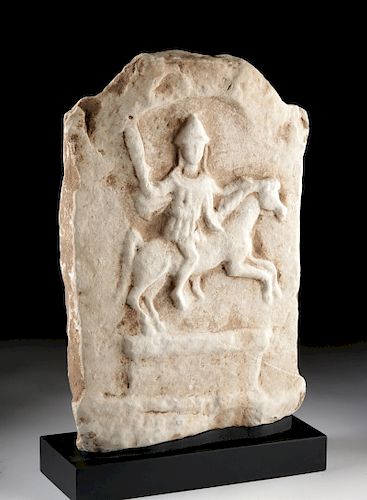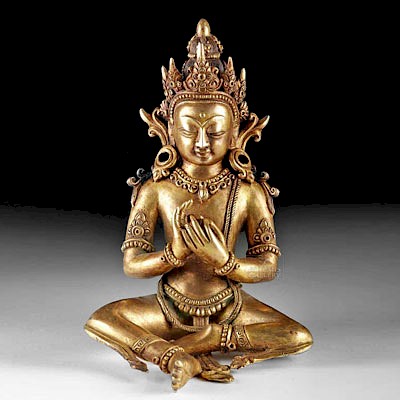Thracian Limestone Equestrian Stela
Lot 65
About Seller
Artemis Fine Arts
686 S Taylor Ave, Ste 106
Louisville, CO 80027
United States
Selling antiquities, ancient and ethnographic art online since 1993, Artemis Gallery specializes in Classical Antiquities (Egyptian, Greek, Roman, Near Eastern), Asian, Pre-Columbian, African / Tribal / Oceanographic art. Our extensive inventory includes pottery, stone, metal, wood, glass and textil...Read more
Estimate:
$2,500 - $3,500
Absentee vs Live bid
Two ways to bid:
- Leave a max absentee bid and the platform will bid on your behalf up to your maximum bid during the live auction.
- Bid live during the auction and your bids will be submitted real-time to the auctioneer.
Bid Increments
| Price | Bid Increment |
|---|---|
| $0 | $25 |
| $300 | $50 |
| $1,000 | $100 |
| $2,000 | $250 |
| $5,000 | $500 |
| $10,000 | $1,000 |
| $20,000 | $2,500 |
| $50,000 | $5,000 |
| $100,000 | $10,000 |
| $200,000 | $20,000 |
About Auction
By Artemis Fine Arts
Jun 6, 2019
Set Reminder
2019-06-06 10:00:00
2019-06-06 10:00:00
America/New_York
Bidsquare
Bidsquare : VARIETY AUCTION | Ancient & Ethnographic
https://www.bidsquare.com/auctions/artemis-gallery/variety-auction-ancient-ethnographic-4182
Around the world & back in time - be amazed at the treasures you will find. Antiquities from Egypt, Greece, Italy and the Near East, Asian, Pre-Columbian, African / Tribal / Oceanic, Native American, Spanish Colonial, Russian Icons, Fine Art, much more! All categories, all price ranges...all legal Artemis Fine Arts info@artemisfinearts.com
Around the world & back in time - be amazed at the treasures you will find. Antiquities from Egypt, Greece, Italy and the Near East, Asian, Pre-Columbian, African / Tribal / Oceanic, Native American, Spanish Colonial, Russian Icons, Fine Art, much more! All categories, all price ranges...all legal Artemis Fine Arts info@artemisfinearts.com
- Lot Description
Southeastern Europe, Thrace (modern borders in Bulgaria, Greece, and Turkey), ca. 1st century BCE to 2nd century CE. A carved pedimented limestone stele with a recess containing a Thracian Rider mounted upon a striding horse, the pair upon a rectangular plinth, all in bas relief. The figure wears a short chiton or tunic that is wonderfully detailed with a scarf or sash, belt, and pleats, and a pointed helmet; his raised right hand clenching a staff, or perhaps a decorated hunting horn or spear; his left holding the reigns of the galloping horse. Thracian horseman symbolizing victory and strength were a recurring motif on eastern Balcanic mythology during the Roman era. Size: 10.5" W x 15" H (26.7 cm x 38.1 cm); 17" H (43.2 cm) on included custom stand.
Scholars believe this riding hero to be the main deity of Ancient Thrace who was extremely popular in the Roman period and did not appear to have a name, but instead was referred to only as "the hero". A widespread cult of gods or heroes who appeared as hunters or riders on horseback existed from about 1000 BCE. Some examples include the Greek Dioscuri, Castor and Pollux, the Romano-Celtic Jupiter Taranis and the Danubian rider-gods. A superb example of this wondrous mythological figure!
For additional discussion of this iconography, see Nicolae, C. The Iconography of the Antique Hero in the Balkan Area, in Marisia vol. XXXI, 2011.
Provenance: private East Coast, USA collection; ex-Richard Wagner collection, Cape Cod, Massachusetts, USA, acquired in the 1970s
All items legal to buy/sell under U.S. Statute covering cultural patrimony Code 2600, CHAPTER 14, and are guaranteed to be as described or your money back.
A Certificate of Authenticity will accompany all winning bids.
We ship worldwide and handle all shipping in-house for your convenience.
#146227Normal surface wear and abrasions with earthen deposits. Old losses to peripheries as shown. Still, strong details remaining and nicely preserved given its age.Condition
- Shipping Info
-
All shipping is handled in-house for your convenience. Your invoice from Artemis Gallery will include shipping calculation instructions. If in doubt, please inquire BEFORE bidding for estimated shipping costs for individual items.
-
- Buyer's Premium



 EUR
EUR CAD
CAD AUD
AUD GBP
GBP MXN
MXN HKD
HKD CNY
CNY MYR
MYR SEK
SEK SGD
SGD CHF
CHF THB
THB














